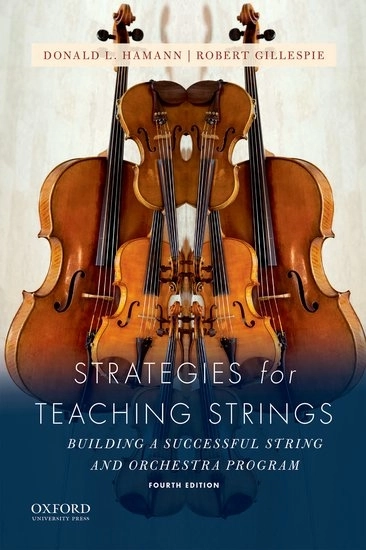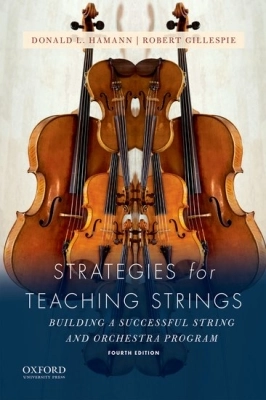Opens in a new window
Oxford University Press Strategies for Teaching Strings: Building A Successful String and Orchestra Program (Fourth Edition) - Hamann/Gillespie - Book

- Composer/Author: HAMANN/GILLESPIE
- Model # 9780190643850
Format: Book
Version: Music Text
Strategies for Teaching Strings: Building a Successful String and Orchestra Program, Fourth Edition, is an essential guide for prospective, novice, and experienced string teachers alike. This comprehensive text provides all the information necessary to develop and manage a successful school-based program. Based on the national standards for teaching strings and orchestra, the text covers performance objectives, strategies for teaching technical and performance skills, and solutions to common playing problems for elementary, middle, and high school skill levels. It also offers rehearsal strategies to develop large-group ensemble techniques, practical approaches to teaching improvisation, and advice on how to increase student recruitment and retention.
Contents:
- Strategies for Teaching Strings Companion Website Video Content
- Preface
- How To Use The Book
- Chapter 1. The String Instrument Family
- Instruments
- Bows
- Accessories and Supplies
- Selecting String Instruments
- Care and Maintenance of String Instruments and Bows
- Summary
- Resources
- Chapter 2. Beginning String Class Instruction
- Guiding Principles for Teaching Beginning String Classes
- Recommended Seating Configuration for Beginning String Classes
- Performance Goals and Objectives of First- and Second-Year String Classes
- Strategies for Determining Proper Instrument Sizes
- Pedagogy for Teaching Instrument Position
- Creating Lesson Plans for Beginning String Class Instruction
- Body Posture Teaching Strategies
- Instrument Position Teaching Strategies
- Left-Hand Shape: General Guidelines
- Pedagogy for Teaching the Left-Hand Shape
- Pedagogy for Teaching Pizzicato
- Pedagogy for Teaching Beginning Finger Placement
- Bowing Instruction: General Guidelines
- Bow Hand Shape: General Guidelines
- Pedagogy for Teaching Bow Hand Shape
- Sound Production Principles
- Dtach Bowing: General Guidelines
- Pedagogy for Teaching Detache Bowing
- Beginning String Crossings: General Guidelines
- Pedagogy for Teaching String Crossings
- Staccato and Hooked Bowings: General Guidelines
- Pedagogy for Teaching String Staccato and Hooked Bowings
- Pedagogy for Teaching Slurs
- Aural Skill Development in Beginning Classes: General Guidelines
- Pedagogy for Teaching Beginning Aural Skills
- Strategies for Teaching Instrument Tuning in Beginning String Classes
- Problem Solving: Beginning Students' Common Playing Problems and Solutions
- References
- Additional Resources
- Chapter 3. Intermediate Sting Class Instruction
- Performance Goals and Objectives of Third- and Fourth-Year String Classes
- Pedagogy for Teaching Parallel Bowing
- Pedagogy for Teaching Smooth Direction Changes
- Pedagogy for Teaching Tone Production at Different Dynamic Levels
- Pedagogy for Teaching Moderate-to-Faster Tempo String Crossings
- Pedagogy for Teaching Slurring More than Four Notes
- Pedagogy for Teaching Martel Bowing
- Pedagogy for Teaching Basic Spiccato
- Pedagogy for Teaching Consistent Lengthened and Balanced Body Posture
- Pedagogy for Refining Instrument Position
- Intermediate Left-Hand Skills: General Guidelines
- Pedagogy for Refining Left-Hand Shapes
- Pedagogy for Teaching Cello Extensions
- Shifting: General Principles
- Pedagogy for Teaching Shifting
- Vibrato: General Principles
- Pedagogy for Teaching Vibrato
- Double Bass Pivoting: General Guidelines
- Pedagogy for Developing Intermediate Aural Skills in the School Orchestra
- Intermediate Instrument Tuning
- Problem Solving: Intermediate Students' Common Playing Problems and Solutions
- References
- Additional Resources
- Chapter 4. Advanced String Class Instruction
- Goals and Objectives of Advanced Playing Skills
- Pedagogy for Teaching Expressive Detache Bowing
- Pedagogy for Teaching Loure (Portato) Bowing
- Pedagogy for Teaching Sul Tasto Bowing
- Pedagogy for Teaching Ponticello Bowing
- Pedagogy for Teaching Controlled Tremolo Bowing
- Pedagogy for Teaching Colle Bowing
- Pedagogy for Teaching Fast String Crossings
- Pedagogy for Teaching Expressive Spiccato
- Two-Octave Scales through Four Sharps and Four Flats: General Guidelines
- Introducing Three-Octave Scales: General Guidelines
- Pedagogy for Refining Shifting
- Pedagogy for Refining Vibrato
- Pedagogy for Developing Advanced Aural Skills in the School Orchestra
- Advanced Instrument Tuning
- Problem Solving: Advanced Students' Common Playing Problems and Solutions
- References
- Additional Resources
- Chapter 5. The School Orchestra Program
- A Brief History of Orchestra Programs in the Schools
- Values of Orchestra Programs in the School Music Curriculum
- Strategies for Defending the School Orchestra Program
- Developing Community Support for the Orchestra Program
- The School Orchestra Curriculum
- Enhancing the Orchestra Curriculum
- References
- Additional Resources
- Chapter 6. Preparing for Your Orchestra Rehearsal
- Preparing Your Rehearsal Room and Equipment
- Factors to Consider in the Preparation of Your Rehearsal Strategies
- Differences and Commonalties in Teaching Wind, Brass, and String Instruments
- Choosing Music for Your Groups
- Score Preparation
- Lesson Planning
- Auditions/Tryouts
- Nearing the Rehearsal
- References
- Additional Resources
- Chapter 7. "Conducting" Your Rehearsal
- Tuning
- Warm-Ups
- Review of Old and Introduction of New Materials
- Sight Reading and Improvisation
- End of the Rehearsal
- Troubleshooting During Rehearsals
- Effective Teacher/Director Presentation
- Other Considerations
- Resources
- Chapter 8. Practical Approaches to Teaching Improvisation in the School Orchestra
- Rationale
- Improvisation Teaching Strategies
- A Creative Drone Approach
- A Riff Approach
- A Call-and-Response or Question-and-Answer Approach
- A Chordal Approach
- A Rhythmic Ostinato Approach
- Martin Norgaard Six Step Exercises
- Riff Around
- D Blues
- A Four-Bar Approach: Play 2 Bars-Improv-Play 1 Bar
- Summary
- References
- Additional Resources
- Chapter 9. Using Technology in Your Rehearsal
- First Steps
- Additional Resources
- Chapter 10. String Student Recruitment and Retention
- Philosophy
- Why Children Choose to Play Instruments
- Preparation for Recruitment
- Recruitment Procedures
- Retention
- References
- Additional Resource
- Chapter 11. Method Books and Music for the School Orchestra Program
- Guidelines for Choosing Music
- String Method Books and Method Book Evaluation Criteria
- Recommended Publishers
- String and Full Orchestra Literature: Criteria for Grade-Level Distinctions
- References
- Additional Resources
- Appendix A: Correlated String Orchestra Music and Teaching Strategies to Develop Bowing and Left-Hand Playing Skills
- Appendix B: The ASTA National String Teaching Standards
- Appendix C: The Survey of Teaching Effectiveness
- Appendix D: Additional Pedagogical Resources
- Index
Q & A
There are currently no questions for this product.
Reviews
There are currently no reviews for this product. Be the first to write one!




